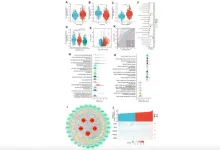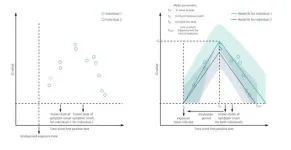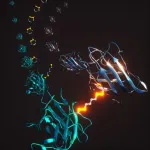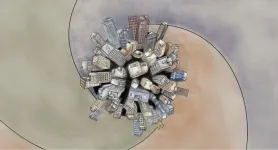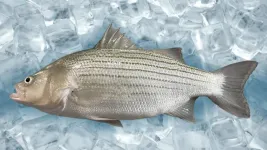(Press-News.org) An international team that includes Rutgers University–New Brunswick scientists has developed a new method to make and manipulate a widely studied class of high-temperature superconductors.
This technique should pave the way for the creation of unusual forms of superconductivity in previously unattainable materials.
When cooled to a critical temperature, superconductors can conduct electricity without resistance or energy loss. These materials have intrigued physicists for decades because they can achieve a state of perfect conductivity allowing an electric current to flow indefinitely. But most superconductors only exhibit this peculiarity at temperatures so low – a few degrees above absolute zero – which renders them impractical.
The new work, published in Science, describes experiments that grew out of theoretical calculations that included those by a Rutgers team led by Jedediah Pixley, an associate professor in the Department of Physics and Astronomy in the Rutgers School of Arts and Sciences.
The experiments confirmed predictions by Pixley and Pavel Volkov, who at the time was a postdoctoral fellow at the Rutgers Center for Materials Theory. These predictions, based on mathematical models Pixley and Volkov (now at the University of Connecticut) devised to represent the underlying quantum physical behavior, projected how cuprate superconductors would behave if they were placed in proximity in specific configurations and at varying angles.
Superconductors are already in use today. Since the 1970s, scientists have employed superconducting magnets to generate the powerful magnetic fields needed for the operation of magnetic resonance imaging (MRI) machines. Maglev trains using the technology were introduced in the 1980s. More recently, scientists have harnessed the power of superconducting magnets to guide electron beams in experimental devices such as synchrotrons and accelerators.
In the future, scientists envision a world where ultra-efficient electricity grids, ultrafast and energy-efficient computer chips, and even quantum computers are powered by new kinds of superconducting materials.
The new experiments that validated Pixley and Volkov’s ideas were conducted by a team at Harvard University led by professor and physicist Philip Kim.
“We took two cuprate superconductors – materials that already were interesting – and, in placing them together and twisting them in a precise way, made something else that was very interesting: another superconductor which could have lots of technological applications,” said Pixley, a condensed matter theorist.
Because of its unique properties, the new superconductor is a promising candidate for the world’s first high-temperature, superconducting diode, essentially a switch that controls the flow of electrical current, the researchers said.
Such a device could potentially fuel fledgling industries such as quantum computing, which rely on fleeting phenomena produced in materials like superconductors, they added.
Pixley, who joined the Rutgers faculty in 2017, earned his doctoral degree by studying the conditions involved in producing superconductivity in unconventional materials. The latest research extends the field of “twistronics,” which involves twisting flat layers of two-dimensional materials to produce physical effects at the subatomic level that are observable on the macroscopic scale.
To Pixley, the study enlarges the paradigm of what materials can exhibit superconducting properties when twisted. The work yields other insights, as well.
“At the same time, we have found that this leads to a novel type of ‘magnetic’ superconducting state that has been long sought after, showing definitively that different superconducting phases can be reached via a twist," he said.
The experimentalists first split an extremely thin film of a superconductive cuprate – nicknamed “BSCCO” and made of bismuth strontium calcium copper oxide – into two layers. Then, maintaining frigid conditions, they stacked the layers at a 45-degree twist, like an ice cream sandwich with askew wafers, retaining superconductivity at the fragile interface.
Cuprates are copper oxides that, decades ago, upended the physics world by showing they become superconducting at much higher temperatures than theorists had thought possible. BSCCO is considered a high-temperature superconductor because it starts superconducting at about -288 Fahrenheit. That is very cold by practical standards, but astonishingly high among classical superconductors, which typically must be cooled to about -400 Fahrenheit.
The work opens the door to more experiments, Pixley said.
“It will be very exciting to extend these experiments to other configurations of superconductors – twisted monolayers and a few twisted multilayers of superconductors at small twist angles,” Pixley said.
Other researchers on the study included scientists from the University of British Columbia, Brookhaven National Laboratory, the Leibniz Institute for Solid State and Materials Research in Germany, Seoul National University in South Korea and the National Institute for Materials Science in Japan.
END
Researchers craft new way to make high-temperature superconductors – with a twist
Theory becomes reality when scientists help develop process for twisting materials in ways never thought possible
2024-01-30
ELSE PRESS RELEASES FROM THIS DATE:
Study suggests secret for getting teens to listen to unsolicited advice
2024-01-30
A new study may hold a secret for getting your teenager to listen to appreciate your unsolicited advice.
The University of California, Riverside, study, which included “emerging adults” — those in their late teens and early 20s — found teens will appreciate parents’ unsolicited advice, but only if the parent is supportive of their teens’ autonomy.
Parents support autonomy by providing clear guidelines for limitations and rules that will be enforced. They ...
Tech inefficiencies, piles of (electronic) paperwork, and increased patient volume contribute to burnout of primary care physicians, study finds
2024-01-30
Burnout is an occupational phenomenon that results from chronic workplace stress, according to the World Health Organization. Burnout often includes emotional exhaustion, negative feelings or mental distance from one’s job, and a low sense of accomplishment at work. COVID-19 increased feelings of burnout in primary care physicians, and a new study, sought to understand primary care clinicians’ perspectives on burnout during the COVID-19 pandemic, the causes of burnout, and strategies to improve clinician well-being.
Inefficiencies of electronic health records systems and high levels of documentation contribute ...
XRCC1: A potential prognostic and immunological biomarker in low-grade gliomas
2024-01-30
“We conducted a comprehensive investigation into the potential of XRCC1 as a valuable diagnostic and prognostic indicator in diverse cancer types.”
BUFFALO, NY- January 30, 2024 – A new research paper was published in Aging (listed by MEDLINE/PubMed as "Aging (Albany NY)" and "Aging-US" by Web of Science) Volume 16, Issue 1, entitled, “XRCC1: a potential prognostic and immunological biomarker in LGG based on systematic pan-cancer analysis.”
X-ray repair cross-complementation ...
Functional bladder tissue regenerated using bone marrow cells
2024-01-30
Scientists from Stanley Manne Children’s Research Institute at Ann & Robert H. Lurie Children’s Hospital of Chicago and Northwestern University succeeded in regenerating fully functional urinary bladder tissue in a long-term study utilizing a non-human primate model. This unique model initially created by the Sharma Research Group explores long term bladder tissue regeneration at both anatomical and physiological levels. The Group used a novel biodegradable scaffold seeded with stem and progenitor cells from the animal’s own bone marrow, which demonstrated a higher degree of success than intestinal segments ...
Tribal program takes addiction treatment on the road
2024-01-30
With the national opioid epidemic disproportionately affecting American Indians and Alaska Natives, a tribal confederation in Oregon decided to take matters into their own hands.
The Confederated Tribes of Grand Ronde not only opened Oregon’s first tribally owned opioid treatment program in Salem in 2021, but a year later, the tribe also began what is believed to be the nation’s first tribally operated mobile medication unit. The mobile bus runs a daily circuit from the tribal reservation in Grand Ronde to McMinnville to Salem, seeing patients and dispensing medications directly to tribal members struggling with an opioid use disorder.
The program appears ...
The emergence of successive SARS-CoV-2 variants of concern during 2020-22 created a need to understand the drivers of such growth
2024-01-30
The emergence of successive SARS-CoV-2 variants of concern during 2020-22 created a need to understand the drivers of such growth; this study uses a Bayesian model to reveal how a set of key covariates (the infecting variant, symptom status, age and number of prior exposures) affect viral kinetics at both individual and population levels
#####
In your coverage, please use this URL to provide access to the freely available paper in PLOS Biology: http://journals.plos.org/plosbiology/article?id=10.1371/journal.pbio.3002463
Article Title: Combined analyses of ...
Mutations in the Cu-Zn superoxide dismutase 1 gene SOD1 can cause familial amyotrophic lateral sclerosis (fALS) in a process that involves dissociation of the SOD1 dimer
2024-01-30
Mutations in the Cu-Zn superoxide dismutase 1 gene SOD1 can cause familial amyotrophic lateral sclerosis (fALS) in a process that involves dissociation of the SOD1 dimer; this study shows that a novel cyclic thiosulfinate cross-linker has favorable drug-like properties and can stabilize the SOD1 dimer in vivo, with therapeutic implications for fALS
#####
In your coverage, please use this URL to provide access to the freely available paper in PLOS Biology: http://journals.plos.org/plosbiology/article?id=10.1371/journal.pbio.3002462
Author ...
Prestigious NIH grant explores repetitive DNA sequences and cell dysfunction
2024-01-30
Dr. Jeannine Gerhardt, an assistant professor of stem cell biology in obstetrics and gynecology and in reproductive medicine at Weill Cornell Medicine, has received a five-year, $2.1 million grant from the National Institute of General Medical Sciences (NIGMS), part of the National Institutes of Health, for the study of repetitive DNA and RNA sequences and the mechanisms by which they cause cell dysfunction and diseases.
The NIGMS Maximizing Investigators’ Research Award is intended to support recipients’ research more broadly and flexibly than standard project grants, which must specify proposed research thoroughly in advance.
“This award is particularly nice because ...
As cities grow, how will city trash, wastewater, and emissions rise?
2024-01-30
More than half of the world’s population—4.4 billion people—lives in cities, and that proportion will grow to two-thirds by the year 2050, according to the United Nations.
As the world’s population expands, and becomes increasingly urbanized, many have raised concerns about the impact of waste—from house trash to wastewater to greenhouse gas emissions—on the planet.
“We as a society tend to ignore the unpleasant side of our production,” says Mingzhen Lu, an assistant professor at New York University’s ...
A green alternative for treating Streptococcus iniae bacteria in hybrid striped bass
2024-01-30
Scientists at the United States Department of Agriculture (USDA)’s Agricultural Research Service (ARS) developed a green antibiotic alternative to treat the deadly pathogen Streptococcus iniae in hybrid striped bass, the fourth most farmed finfish in the United States, according to a recent study.
S. iniae is the causative agent of streptococcosis, a disease prevalent in aquaculture and causes a worldwide economic loss of $150 million annually. Disease outbreaks can bankrupt fish farms and ...
LAST 30 PRESS RELEASES:
UMass Amherst chemists develop unique tool for studying RNA
Disappointment alters brain chemistry and behavior
A built-in odometer: new study reveals how the brain measures distance
Stress-related brain signals drive risk of cardiovascular disease in people with depression and anxiety
New details on role of fat transport molecules in Alzheimer’s onset
Study illuminates how an antiviral defense mechanism may lead to Alzheimer’s disease
Spot the males: New gene-editing method could transform mosquito control
AI learns to build simple equations for complex systems
NAU team releases 13 years of detailed U.S. CO2 emissions data
Unveiling how sodium-ion batteries can charge faster than lithium-ion ones
How do childcare tax credits affect children’s long-term health?
Can an electronic nose detect indoor mold?
Do natural disasters have long-term impacts on mortality in older adults?
Modification improves sodium‐ion batteries as an alternative to lithium-ion batteries
Parasports provide a range of benefits for people with cerebral palsy
How does grandparental care affect children’s health?
Why are there so many Nordic mediators?
Young shark species more vulnerable to extinction
Mobile fetal heart monitoring linked to fewer newborn deaths in Tanzania
Bluey’s dad offered professorial chair in archaeology at Griffith University
Beyond small data limitations: Transfer learning-enabled framework for predicting mechanical properties of aluminum matrix composites
Unveiling non-thermal catalytic origin of direct current-promoted catalysis for energy-efficient transformation of greenhouse gases to valuable chemicals
Chronic breathlessness emerging as a hidden strain on hospitals
Paleontologists find first fossil bee nests made inside fossil bones
These fossils were the perfect home for ancient baby bees
Not everyone reads the room the same. A new study examines why.
New research identifies linked energy, immune and vascular changes in ME/CFS
Concurrent frailty + depression likely boost dementia risk in older people
Living in substandard housing linked to kids’ missed schooling and poor grades
Little awareness of medical + psychological complexities of steroid cream withdrawal
[Press-News.org] Researchers craft new way to make high-temperature superconductors – with a twistTheory becomes reality when scientists help develop process for twisting materials in ways never thought possible
